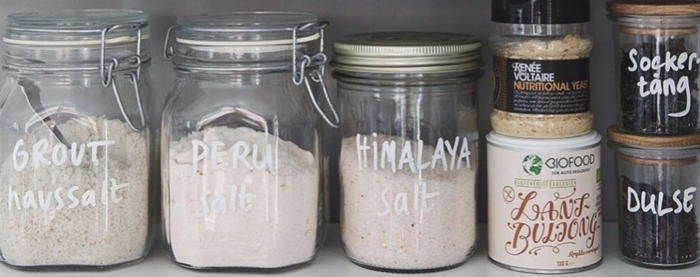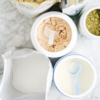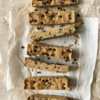The Keto Flu: Symptoms And How To Prevent It?

Given up already on the ketogenic diet because of headaches, dizziness, muscle spasms, cravings or nausea? You may have experienced the "keto flu."
While it can be discouraging, the keto flu is not a direct sign that this diet is not for you; it may actually be a sign that your body is still used to carbohydrates or lacks the conditions necessary for ketone production. Maybe you just need a gentler transition. Let's discuss what exactly is causing these symptoms and what you can do to ease the transition.
But first, what is the keto flu?
The keto flu is a combination of symptoms that can occur during the transition from using glucose as fuel to using fats and ketones as fuel - which, if you didn't already know, is the purpose of the keto diet. Symptoms of the keto flu can vary from headaches and dizziness to muscle cramps and nausea. Symptoms tend to be more severe when the dietary transition is extreme. For instance, if you are used to a high-carbohydrate diet, you are more likely to experience keto flu symptoms than someone who was already eating a lower carbohydrate diet. Individuals who have blood sugar issues, are also more likely to experience symptoms.
What causes the keto flu?
Limiting carbohydrate intake and focusing on healthy fats in your diet has many benefits, including weight loss, improved cognitive function and blood sugar balance, but unfortunately is sometimes accompanied by side effects. This has to do with electrolyte instability and insulin levels.
Electrolyte instability
In the body, carbohydrates are broken down and stored as glycogen, and glycogen then binds water to it. For every 1 gram of carbohydrate stored in the body, about 3 grams of water is bound to it.
When switching to carbohydrate restriction, it can cause many water shifts in the body, rejecting electrolytes and causing muscle cramps, thirst and headaches.
The water loss in the first two to three days can lead to weight loss, but it is important to compensate for this water loss by drinking more fluids (and especially quality water!) to avoid dehydration and electrolyte instability.
If you are an athlete and sweat a lot during exercise or use a sauna, take it easy especially and consider electrolyte supplementation. More on that later.
Insulin levels
In addition to water balance and electrolytes, insulin can also cause keto flu symptoms. This is particularly true if the transition from a high-carbohydrate - or even a moderate-carbohydrate diet - to a very low-carbohydrate diet is too decisive. We explain below how to enter this process in stages.
How can you avoid the keto flu?
For you, everything is different now. You only eat fresh carbohydrates from whole plants. There is almost no salt in them. In addition, you make less insulin and therefore lose salts and electrolytes faster. So it's a good idea to adjust your minerals to ketogenic diet.
Experts of ketogenic eating recommend the following daily doses of electrolytes:
- Sodium (sodium): 5 - 7 grams
- Potassium (potassium): 1 - 3.5 grams
- Magnesium: 0.3 - 0.5 grams
Calcium and Chloride are also often included among the electrolytes. The recommended amounts for calcium and chloride are from the Dutch government:
- Calcium: 800 mg
- Chloride: 800 mg
These amounts are not specific to ketogenic eating, but they are good guidelines to avoid deficiency.
Tips
Take as much salt with meals as you like. You can also dissolve a little salt in filtered water and drink it throughout the day. Preferably use Celtic sea salt.
Potassium and magnesium are better taken as a supplement. Webshop LiveHelfi offers a handy supplement of electrolytes which contains all the electrolytes mentioned: Keto Electrolytes from Perfect Keto.
Start the day with half a liter of water with a teaspoon of salt. After sleeping, you are quite dehydrated. By taking salt and water, you'll quickly be well hydrated again.
You don't always get thirsty when you need water. Sometimes it feels like an appetite, because a meal always contains salt and water. Therefore, try to drink a glass of salted water first if you get hungry before you actually eat a meal.
Boost ketones with MCT oil
To return to the insulin problem. As we discussed earlier, your body makes a serious metabolic shift with the keto diet. It goes from making glucose to ketones and can be taxed as a result. Not to mention, if you are insulin resistant, it can take longer for your body to produce ketones. MCTs are the solution to speed up this process.
MCTs (Medium Chain Triglycerides) are fats with relatively short chains. As a result, the body handles MCTs differently than other fats. The MCTs C8 (octanoic or caprylic acid) and C10 (decanoic or capric acid) are used quickly for energy and are the most digestible relative to other MCTs, such as C6 or C12. Of all the MCTs, C8 is the fastest absorbed and used for energy and ketone production.
Adding NoordCode MCT Oil (or the C8 version) to your morning tea or coffee can help you get through the keto flu.
Remember, for everything, listen to your body; don't overdo it; take salt and MCTs; and eat whole, real food!
Continue reading?
https://www.marksdailyapple.com/what-do-electrolytes-do/
https://www.marksdailyapple.com/electrolytes-keto/




